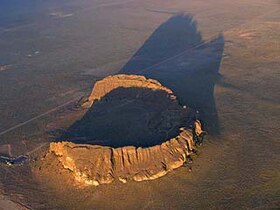Fort Rock State Natural Area
| Fort Rock | |
|---|---|

Aerial view of Fort Rock from the northeast.
|
|
| Highest point | |
| Elevation | 4,699 ft (1,432 m) NAVD 88 |
| Prominence | 345 ft (105 m) |
| Coordinates | 43°22′20″N 121°04′26″W / 43.372094181°N 121.074011483°WCoordinates: 43°22′20″N 121°04′26″W / 43.372094181°N 121.074011483°W |
| Geography | |
| Location | Lake County, Oregon, U.S. |
| Parent range | Basin and Range |
| Geology | |
| Age of rock | 50,000 to 100,000 years |
| Mountain type | Tuff ring |
| Climbing | |
| Easiest route | Trail |
| Designated | 1976 |
Fort Rock is a volcanic landmark called a tuff ring, located on an ice age lake bed in north Lake County, Oregon, United States. The ring is about 4,460 feet (1,360 m) in diameter and stands about 200 feet (60 m) high above the surrounding plain. Its name is derived from the tall, straight sides that resemble the palisades of a fort. The region of Fort Rock Basin contains about 40 such tuff rings and maars and is located in the Brothers Fault Zone of central Oregon's Great Basin. William Sullivan, an early settler in the area, named Fort Rock in 1873 while searching for lost cattle.
Fort Rock was created when basalt magma rose to the surface and encountered the wet muds of a lake bottom. Powered by a jet of steam, molten basalt was blown into the air, creating a fountain of hot lava particles and frothy ash. The pieces and blobs of hot lava and ash rained down around the vent and formed a saucer-shaped ring of lapilli tuff and volcanic ash sitting like an island in the lake waters. Steam explosions also loosened angular chunks of black and red lava rock comprising the valley floor. These blocky inclusions are incorporated into the fine-grained tuff layers at Fort Rock. Waves from the lake waters eroded the outside of the ring, cutting the steep cliffs into terraces 66 feet (20 m) above the floor of Fort Rock Valley.
The wave-cut terraces on the south side of the ring mark former lake levels of this now-dry lakebed. Southerly winds, which are still predominant in this region, apparently drove waves against the south side of the ring, eroding the soft ash layers, breaching it, and creating a large opening on the south side.
...
Wikipedia
